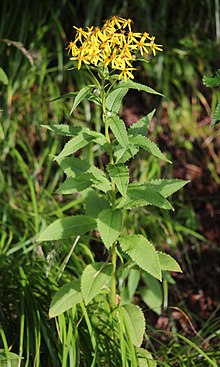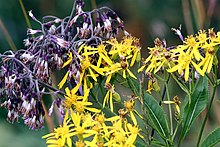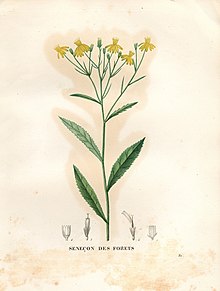Grove ragwort
| Grove ragwort | ||||||||||||
|---|---|---|---|---|---|---|---|---|---|---|---|---|

Grove ragwort ( Senecio nemorensis ) |
||||||||||||
| Systematics | ||||||||||||
|
||||||||||||
| Scientific name | ||||||||||||
| Senecio nemorensis | ||||||||||||
| L. |
The grove-groundsel ( Senecio nemorensis ) is a plant from the genus of Senecio ( Senecio ) within the family of Compositae (Asteraceae). It is widespread in Eurasia .
description
Vegetative characteristics
Grove ragwort grows as a perennial herbaceous plant and reaches heights of up to 1 meter. There are rhizomes formed. Per plant specimen there is usually one, sometimes several, independently upright stems that are not branched below the inflorescences and are sparsely hairy or almost bare.
There are basal and stem leaves. The lowest leaves wither to anthesis . The many central stem leaves are arranged alternately and almost sessile and almost encompassing the stem. Their parchment-like, simple leaf blades are 10 to 18 centimeters long and 2.5 to 4 centimeters wide and lanceolate or oblong-lanceolate with a wedge-shaped narrowing blade base and a pointed-pointed or pointed upper end. Their leaf surfaces are sparsely hairy or almost bare. There is pinnate nerve with 14 to 18 lateral nerves. Their leaf margins are densely serrated or rarely serrated. The top leaves are slightly smaller.
Generative characteristics
The flowering period in China extends from June to December. The composite, umbrella-like total inflorescences contain many cup-shaped partial inflorescences . The slender stems of the flower heads are 1.5 to 3 centimeters long. The three or four bracts per flower head are linear and sparsely hairy with a length of 5 to 10 millimeters. The flower head cover (involucre) is almost cylindrical with a length of 6 to 7 millimeters and a width of 4 to 5 millimeters. The four or five linear outer bracts are shorter than the involucre. The 12 to 18 herbaceous, fluffy hairy bracts are elongated with a length of 6 to 7 millimeters and a width of 1 to 2 millimeters with a broad, dry-skinned edge, which is downy hairy and at the top triangular-pointed and brown downy hairy.
The flower baskets contain eight to ten zygomorphic ray- flowers (= ray-flowers) on the edge and 15 to 16 radially symmetrical tubular flowers (= disc- shaped flowers ) inside . All flowers are fertile. The ray-florets have a corolla tube about 5 millimeters long and a yellow, with a length of 11 to 13 millimeters and a width of 2.5 to 3 millimeters linear-elongated, three-pronged tongue, which is four-nerved. In the yellow, funnel-shaped tubular flowers, the corolla tubes have a diameter of 8 to 9 millimeters and a length of 3.5 to 4 millimeters and their papillary , about 1 millimeter long corolla lobes are ovate-triangular with a pointed upper end. The anthers are about 3 millimeters long with ovate-lanceolate appendages.
The bald achenes are cylindrical with a length of 4 to 5 millimeters. The white pappus is 7 to 8 millimeters long.
The number of chromosomes is 2n = 40.
Site conditions
The Senecio nemorensis thrives in China in the mountains at altitudes from 700 to 2000 meters. The grove ragwort thrives in large parts of the Palearctic in suitable habitats, for example in deciduous and mixed forests.
Systematics and distribution
The first publication of Senecio nemorensis was made in 1753 by Carl Linnaeus in Species Plantarum 870, 2, p synonyms for Senecio nemorensis L. are: Senecio ganpinensis Vaniot , Senecio kematongensis Vaniot , Senecio nemorensis var. Octoglossus Ledeb (DC.). , Senecio nemorensis var. Subinteger H.Hara , Senecio nemorensis var. Taiwanensis (Hayata) Yamam. , Senecio nemorensis var. Turczaninowii (DC.) Kom. , Senecio octoglossus DC. , Senecio octoglossus var. Macer DC. , Senecio sarracenicus var. Turczaninowii (DC.) Nakai , Senecio taiwanensis Hayata , Senecio tozanensis Hayata .
Senecio nemorensis belongs with up to eight other species to the grove ragwort species group ( Senecio nemorensis agg.) From the genus Senecio .
Senecio nemorensis is widespread in Eurasia . It is found in Southern, Central and Eastern Europe , Turkey , Central Asia , Russia , Mongolia , Japan , Korea , China and Taiwan .
One can distinguish several subspecies in Europe:
- Senecio nemorensis L. subsp. nemorensis : It occurs in Europe only in Russia. The number of chromosomes is 2n = 40.
- Senecio nemorensis subsp. apuanus (exchange) Greuter (syn .: Senecio apuanus exchange ): This endemic occurs in Italy only in the Apulia region.
- Senecio nemorensis subsp. bulgaricus (Velen.) Greuter : It occurs in Romania , Bulgaria , Greece , Macedonia , Serbia , Bosnia and Herzegovina and Turkey .
- Senecio nemorensis subsp. glabratus (Herborg) Oberpr. : It occurs in Germany, Austria, Italy and Slovenia.
- Jacquin's ragwort, German ragwort ( Senecio nemorensis subsp. Jacquinianus (Rchb.) Čelak. , Syn .: Senecio germanicus Wallr. ): It occurs in Germany , Austria , Italy , Hungary , Slovenia , Croatia , the Czech Republic, Poland , in the Slovakia , Ukraine , Russia, Romania and Greece. The number of chromosomes is 2n = 40.
use
The stems of Senecio nemorensis are eaten pickled.
Individual evidence
- ↑ a b c d e f g h i j k Senecio nemorensis , p. 517 - the same text online as the printed work , In: Wu Zheng-yi, Peter H. Raven & Deyuan Hong (eds.): Flora of China , Volume 20 - Asteraceae , Science Press and Missouri Botanical Garden Press, Beijing and St. Louis, 2011, ISBN 978-1-935641-07-0 .
- ^ Linnaeus scanned in at biodiversitylibrary.org in 1753 .
- ↑ Senecio nemorensis at Tropicos.org. Missouri Botanical Garden, St. Louis, accessed June 19, 2017.
- ↑ Senecio nemorensis agg., Grove ragwort (species group). In: FloraWeb.de.
- ↑ Senecio nemorensis in the Germplasm Resources Information Network (GRIN), USDA , ARS , National Genetic Resources Program. National Germplasm Resources Laboratory, Beltsville, Maryland. Retrieved March 12, 2018.
- ↑ a b c d e f Werner Greuter (2006+): Compositae (pro parte majore). In: Werner Greuter, E. von Raab-Straube (Ed.): Compositae. : Datasheet Senecio nemorensis In: Euro + Med Plantbase - the information resource for Euro-Mediterranean plant diversity.
- ↑ a b Senecio nemorensis at Tropicos.org. In: IPCN Chromosome Reports . Missouri Botanical Garden, St. Louis
- ↑ Senecio nemorensis at Plants For A Future . Retrieved March 12, 2018.




